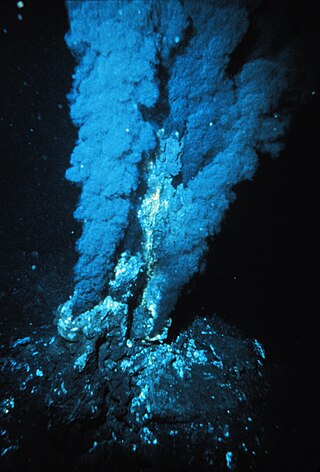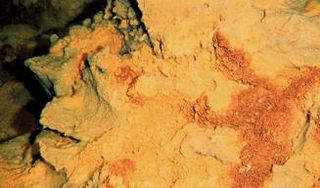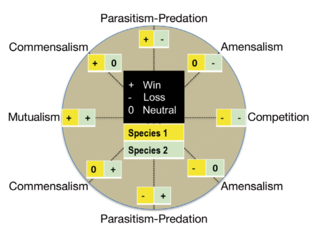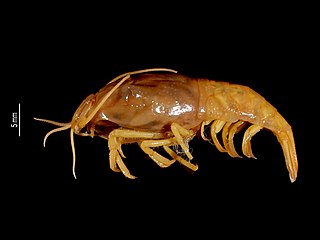
Ectosymbiosis is a form of symbiotic behavior in which an organism lives on the body surface of another organism, including internal surfaces such as the lining of the digestive tube and the ducts of glands. The ectosymbiotic species, or ectosymbiont, is generally an immobile organism existing off of biotic substrate through mutualism, commensalism, or parasitism. Ectosymbiosis is found throughout a diverse array of environments and in many different species.

Hydrothermal vents are fissures on the seabed from which geothermally heated water discharges. They are commonly found near volcanically active places, areas where tectonic plates are moving apart at mid-ocean ridges, ocean basins, and hotspots. The dispersal of hydrothermal fluids throughout the global ocean at active vent sites creates hydrothermal plumes. Hydrothermal deposits are rocks and mineral ore deposits formed by the action of hydrothermal vents.

Riftia pachyptila, commonly known as the giant tube worm and less commonly known as the giant beardworm, is a marine invertebrate in the phylum Annelida related to tube worms commonly found in the intertidal and pelagic zones. R. pachyptila lives on the floor of the Pacific Ocean near hydrothermal vents. The vents provide a natural ambient temperature in their environment ranging from 2 to 30 °C, and this organism can tolerate extremely high hydrogen sulfide levels. These worms can reach a length of 3 m, and their tubular bodies have a diameter of 4 cm (1.6 in).

Alvinocarididae is a family of shrimp, originally described by M. L. Christoffersen in 1986 from samples collected by DSV Alvin, from which they derive their name. Shrimp of the family Alvinocarididae generally inhabit deep sea hydrothermal vent regions, and hydrocarbon cold seep environments. Carotenoid pigment has been found in their bodies. The family Alvinocarididae comprises 7 extant genera.

Mirocaris is a genus of shrimp associated with hydrothermal vents. Sometimes considered the only genus of the family Mirocarididae, Mirocaris is usually placed in the broader family Alvinocarididae. Mirocaris is characterized by a dorsoventrally flattened, non-dentate rostrum, as well as the possession of episodes on the third maxilliped through to the fourth pteropod. The genus contains two species, M. fortunata and M. indica. The two species are found in different oceans, and can be distinguished by the pattern of setation on the claw of the first pereiopod.

Kiwa hirsuta is a crustacean discovered in 2005 in the South Pacific Ocean. This decapod, which is approximately 15 cm (5.9 in) long, is notable for the quantity of silky blond setae covering its pereiopods. Its discoverers dubbed it the "yeti lobster" or "yeti crab".

Kiwa is a genus of marine decapods living at deep-sea hydrothermal vents and cold seeps. The animals are commonly referred to as "yeti lobsters" or "yeti crabs”, after the legendary yeti, because of their "hairy" or bristly appearance. The genus is placed in its own family, Kiwaidae, in the superfamily Chirostyloidea. The genus Kiwa is named after the god of shellfish in Polynesian mythology.
Symbiotic bacteria are bacteria living in symbiosis with another organism or each other. For example, rhizobia living in root nodules of legumes provide nitrogen fixing activity for these plants.

Gammaproteobacteria is a class of bacteria in the phylum Pseudomonadota. It contains about 250 genera, which makes it the most genus-rich taxon of the Prokaryotes. Several medically, ecologically, and scientifically important groups of bacteria belong to this class. All members of this class are Gram-negative. It is the most phylogenetically and physiologically diverse class of the Pseudomonadota.

Chrysomallon squamiferum, commonly known as the scaly-foot gastropod, scaly-foot snail, sea pangolin, or volcano snail is a species of deep-sea hydrothermal-vent snail, a marine gastropod mollusc in the family Peltospiridae. This vent-endemic gastropod is known only from deep-sea hydrothermal vents in the Indian Ocean, where it has been found at depths of about 2,400–2,900 m (1.5–1.8 mi). C. squamiferum differs greatly from other deep-sea gastropods, even the closely related neomphalines. In 2019, it was declared endangered on the IUCN Red List, the first species to be listed as such due to risks from deep-sea mining of its vent habitat.

The class Zetaproteobacteria is the sixth and most recently described class of the Pseudomonadota. Zetaproteobacteria can also refer to the group of organisms assigned to this class. The Zetaproteobacteria were originally represented by a single described species, Mariprofundus ferrooxydans, which is an iron-oxidizing neutrophilic chemolithoautotroph originally isolated from Kamaʻehuakanaloa Seamount in 1996 (post-eruption). Molecular cloning techniques focusing on the small subunit ribosomal RNA gene have also been used to identify a more diverse majority of the Zetaproteobacteria that have as yet been unculturable.

Bathymodiolus thermophilus is a species of large, deep water mussel, a marine bivalve mollusc in the family Mytilidae, the true mussels. The species was discovered at abyssal depths when submersible vehicles such as DSV Alvin began exploring the deep ocean. It occurs on the sea bed, often in great numbers, close to hydrothermal vents where hot, sulphur-rich water wells up through the floor of the Pacific Ocean.

Microbial symbiosis in marine animals was not discovered until 1981. In the time following, symbiotic relationships between marine invertebrates and chemoautotrophic bacteria have been found in a variety of ecosystems, ranging from shallow coastal waters to deep-sea hydrothermal vents. Symbiosis is a way for marine organisms to find creative ways to survive in a very dynamic environment. They are different in relation to how dependent the organisms are on each other or how they are associated. It is also considered a selective force behind evolution in some scientific aspects. The symbiotic relationships of organisms has the ability to change behavior, morphology and metabolic pathways. With increased recognition and research, new terminology also arises, such as holobiont, which the relationship between a host and its symbionts as one grouping. Many scientists will look at the hologenome, which is the combined genetic information of the host and its symbionts. These terms are more commonly used to describe microbial symbionts.
Caminicella is a Gram-negative, anaerobic, thermophilic, heterotrophic, spore-forming, rod-shaped and motile bacterial genus from the family of Clostridiaceae with one known species.

The hydrothermal vent microbial community includes all unicellular organisms that live and reproduce in a chemically distinct area around hydrothermal vents. These include organisms in the microbial mat, free floating cells, or bacteria in an endosymbiotic relationship with animals. Chemolithoautotrophic bacteria derive nutrients and energy from the geological activity at Hydrothermal vents to fix carbon into organic forms. Viruses are also a part of the hydrothermal vent microbial community and their influence on the microbial ecology in these ecosystems is a burgeoning field of research.
John A. Baross is an American marine microbiologist and professor of oceanography and astrobiology at the University of Washington who has made significant discoveries in the field of the microbial ecology of hydrothermal vents and the physiology of thermophilic bacteria and archaea.
Hydrogen sulfide chemosynthesis is a form of chemosynthesis which uses hydrogen sulfide. It is common in hydrothermal vent microbial communities Due to the lack of light in these environments this is predominant over photosynthesis

The Kairei vent field is a hydrothermal vent field located in the Indian Ocean at a depth of 2,460 metres (8,070 ft). It is just north of the Rodrigues Triple Junction, approximately 2,200 kilometres (1,400 mi) east from Madagascar. It is the first hydrothermal field discovered in the Indian Ocean and the first of the series of known vents along the Central Indian Ridge.

Rimicaris kairei is a species of hydrothermal vent shrimp originally discovered in August 2000 with the ROV Kaiko on the R/V Kairei. They are named for the R/V Kairei and the Kairei hydrothermal vent field on which they were first discovered. They get energy from chemosynthetic symbiotic bacteria that live in their gut. They reproduce sexually and have a larval stage in which they consume photosynthetic material. Rimicaris kairei lives on four different hydrothermal vent sites on the Central Indian Ridge in the Indian Ocean. They are the most populous invertebrate on these vents. The species is differentiated from other species of Rimicaris Shrimp by a lack of setae, longer flagellar antennae, and less robust pereopods.
Seamount microbial communities refer to microorganisms living within the surrounding environment of seamounts. Seamounts are often called the hotspot of marine life serving as a barrier that disrupts the current and flow in the ocean, which is referred to as the seamount effect.

















